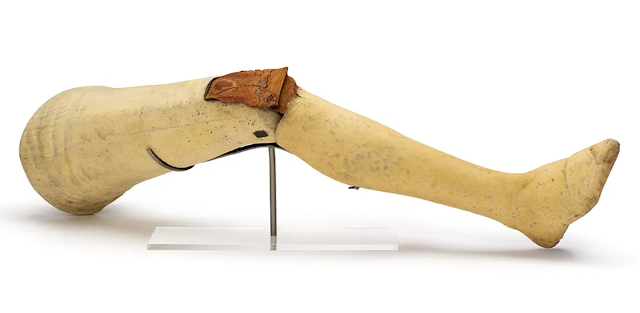HISTORY OF MEDICINE: The Anglesey Leg
Henry Paget: "By God, sir, I've lost my leg!"
Duke of Wellington: "By God, sir, so you have!"
A likely more accurate account comes from Horace Seymour, the man who carried the wounded Paget from the battlefield who recalls the exchange as -
Henry Paget: "I have got it at last!"
Duke of Wellington: "No? Have you, by God?"
Paget was carried from the battlefield to his headquarters where Dr John Hume, with the assistance of two surgeons, James Powell of the Ordnance Medical Department and James Callander of the 7th Hussars, amputated Paget's leg at the mid thigh. Another anecdote records Paget's only comment during the procedure to have been -
"The knives appear to be somewhat blunt."
Whether Paget actually made this remark is uncertain however he did appear to be in good spirits according to his aide-de-camp, Thomas Wildman, who quotes Paget as saying -
"I have had a pretty long run. I have been a beau these forty-seven years, and it would not be fair to cut the young men out any longer."
Paget's leg gained something of a following of it's own - having been buried in the garden of the house which was being used as Paget's headquarters, it was given a tombstone and became something of an attraction. It is believed the bones were eventually incinerated in 1934. The saw which was used to amputate his limb is held by the National Army Museum.
Paget was not the only member of his family to lose a limb during the Napoleonic Wars. His brother, Major-General Sir Edward Paget, began his military career in the 1st Regiment of Life Guards in 1792, then served as an MP for Caernafon between 1796 and 1808. Sent to join the Peninsular War in 1808, he commanded reserve forces at the Battle of Coronna, and then commanded the advance to Oporto. It was during the second battle of Oporto that he lost an arm. Henry Paget's daughter would also be reported as losing a hand while with her husband during the campaign.
Neither of the Paget brothers careers were affected by their missing limbs. Both would remain in the military, with Edward Paget spending much his service in India and Burma, before becoming Governor of the Royal Military College, Sandhurst, and the Royal Hospital Chelsea.
Henry Paget would also continue his military career, and in this effort he was aided by the ingenuity of James Potts of Chelsea - about whom little is widely known. Potts would create a number of prosthetics for Henry Paget following a singular design. This prosthetic had an articulated knee and raising toes to allow a wide range of movement. Paget had several made, and a number are on public display in museums. These articulated prosthetics were not necessarily a completely new development, however the type developed for Paget is the earliest, well documented example, of an articulated prosthetic leg and the approach would become a more widely used standard, becoming known as the Anglesey Leg.
As noted one of the consequences of the Peninsular War was that a greater number of members of the aristocracy, and those with money, became injured - losing hands, arms, feet, and legs - and this led to a wider need for prosthetics, along with a desire for limbs which reached a higher standard by those with the money to pay artisans for new developments. The large need for prosthetics also created a larger market for simple, standardized forms which were suitable for mass production and which could be sold to the user at an affordable price. It is also worth noting that many of these wealth individuals were able to continue their careers in the military through the use of such prosthetics, and the fact that as senior officers they would spend much of their battlefield duty on horseback.
The development of prosthetics has been driven by a number of factors over time, but one of the major factors has always been the amount of need. War, therefore, has been a driver of development. From early replacements seen in medieval manuscripts, to the Anglesey leg, to the developments after both World Wars, to today. Human ingenuity has been and will continue to be applied to the development of these adaptions. They are not without controversy, as the issues of Cochlear implants in the d/Deaf community show, and the ethical issues will only become greater as implants, prosthetics, etc become more advanced. Such issues have been explored in fiction, but they are likely to become even more significant in real world developments as technology advances.
We can in the Anglesey leg see how a combination of need by the wealthy, and human ingenuity led to an advance which would benefit many. We must remember how these developments began, and as we make new advances and consider their overall benefit to all people, not only the wealth in the developed world.
Image Caption A prosthetic leg made for Henry Paget, via Age of Revolution.


